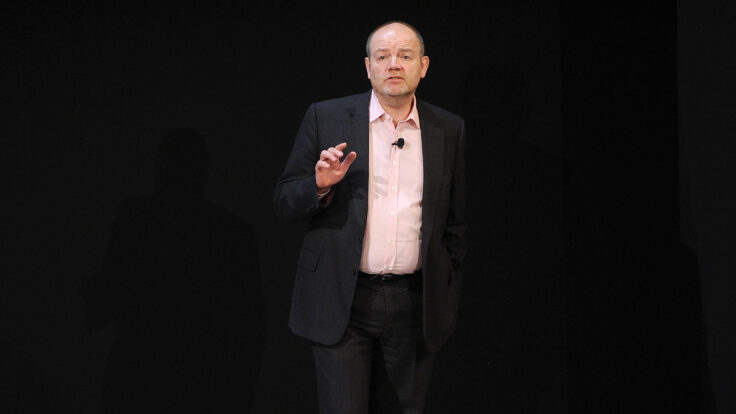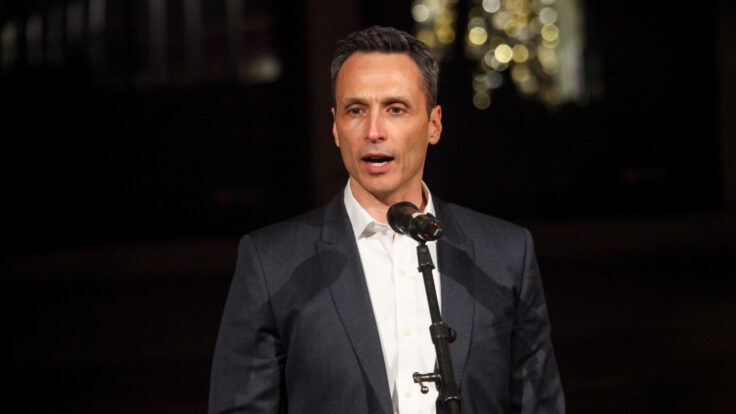Welcome back to The Best & The Brightest. I’m Tara
Palmeri.
We’re just days away from Donald Trump’s big bash, and it feels very different than 2017, when both sides of the aisle were mourning “American Carnage,” fretting over how the Trump carnival would destroy #ThisTown, and canceling events in order to avoid the appearance of “normalizing” the unthinkable. This time around, titans of industry, staffers, and K-Street slickers
are gearing up for all the typical inauguration weekend activities, hosting a party—or better yet, crashing one—to try to grease the palms of the new power elite.
It’s always been a bit demeaning for those who were on the wrong side of a messy primary. With enough alcohol and promises of financial support, some grudges can be settled. Business leaders of the opposite party also find their way to
reconciling with the new administration, with only lightly bruised egos. But the wrath of Trump, and fear of retribution, have made these familiar rituals even more obsequious than I could ever have imagined.
To wit: As I scooped earlier today, Meta boss Mark Zuckerberg has graduated from gifting a million-dollar olive branch to Trump’s inauguration committee to becoming an active
participant in the festivities, teaming up with some of the Republican Party’s biggest donors to co-host a pre-Inaugural Ball reception on Monday night at 6:30 p.m. (“Address provided upon RSVP.”) Zuckerberg’s co-hosts are billionaire Trump ally Miriam Adelson, incoming deputy commerce secretary and Chicago Cubs owner Todd Ricketts and his wife,
Sylvie Légère, and Houston Rockets owner Tilman Fertitta. Can a rented cabana next to Elon’s at Mar-a-Lago be far behind?
In tonight’s issue, I delve into more serious matters: Trump’s campaign promise to conduct one of the biggest deportation operations of all time. For more details on how it might play out, I phoned up his former acting deputy
secretary of Homeland Security, Ken Cuccinelli, to see whether the president-elect can actually deliver—and what success actually looks like. We had a remarkably candid conversation, where Cuccinelli admitted that it would be the largest domestic undertaking by the government in our lifetimes. After all, deporting just 1 million people in one year would be a massive lift.
But first, here’s Abby on
the Hegseth hearing…
|
|
|

|
Abby Livingston
|
|
Pete Hegseth’s confirmation hearing for SecDef earlier today offered
a glimpse into how G.O.P. senators are orienting themselves toward these high-profile events—and also provided some clues about how Kash Patel, Tulsi Gabbard, and the rest of Trump’s controversial noms might play out. Given their 53-47 majority, Republicans are leveraging their upper hand in every way possible, and that’s especially true when there’s a friendly chairman on the relevant committee, as was the case today with Mississippi’s
Roger Wicker at Armed Services. Across the dais, the Democrats appeared sober, organized, and ready to resist—despite lacking the numbers. Here’s the inside chatter…
|
- Spotlight on Ernst: It didn’t surprise anyone that Iowa’s Joni Ernst, the Senate Republican most openly skeptical about Hegseth’s nomination, conducted the most pointed questioning among her party colleagues. Still, she framed her inquiries as if she were trying to get to yes—she extracted assurances, for instance, that Hegseth would “appoint a senior-level official dedicated to sexual assault prevention and response.” Those tells
proved correct within hours, when she announced in a one-sentence statement to Fox News that she would vote for Hegseth. Wicker took a similar tack, allowing Hegseth to answer the most severe allegations against him on his own terms. (The former Fox News anchor again denounced the allegations as a “coordinated smear campaign” by the “left-wing media.”)
When Democratic senators interrogated Hegseth, Wicker responded with procedural pushback by submitting a letter of support relevant to the
line of questioning. Wicker also limited their questioning to one round, despite ranking member Jack Reed’s objection. (Exhausted witnesses are more likely to make mistakes.) In the end, most of the G.O.P. senators framed Hegseth as a redeemed man and the victim of media slander.
- Kelly’s antihero: Despite broader existential despair about their party’s leadership, Armed Services Dems seemed to have their act together, with each
member homing in on a single topic and moving as quickly as possible through questions in their allotted seven minutes. To a person, these sessions were a beatdown for Hegseth, but it was America’s Stepdad, Virginia’s Tim Kaine, who conducted the most ruthless and specific interrogation of Hegseth’s character, dwelling on allegations that the
nominee sexually assaulted a woman in Monterey, California, in 2017. “Holy shit,” texted one Kaine alumnus. Another seasoned Democratic operative texted me, “Tim Kaine has no effs left to give. Just look at his hair.” And yet, of all the questioners, it was Mark Kelly, a Navy man, who got to the nub of the hearing: “Have you overcome personal issues—or are you the target of a smear campaign? It can’t be both.”
- The weeks
ahead: Beyond Ernst, none of the swingy Republican senators—Susan Collins, John Curtis, Lisa Murkowski, etcetera—sit on Armed Services. So the fawning Republican performances earlier today might not be representative of how the rest of the confirmation hearings might play out. On the other hand, one Democrat I spoke with conceded that Hegseth will likely be confirmed, before summing up what the minority party
achieved today: “We’re showing why he shouldn’t.”
|
|
|
In this remarkably candid conversation, former Trump Homeland
Security official Ken Cuccinelli reveals what the president-elect’s “day one” immigration promises actually entail—and how he’ll try to keep them.
|
|
|
One of Donald Trump’s most quoted campaign
promises was to launch, on day one, “the largest deportation program of criminals in the history of America.” But, perhaps needless to say, he’s not going to be able to kick millions of illegal immigrants out of the country on January 20. Actually removing people is the hypothetical end point of what will inevitably be a dragged-out, vociferous, politically fraught, and logistically complex process involving warrants, identification, surveillance, detention, and many, many
lawyers. It’s an enormous—and enormously expensive—undertaking.
But if Trump does attempt to implement his feverish campaign promise, how will he go about it? To get a candid perspective, I spoke with Ken Cuccinelli, a former Virginia attorney general and Trump’s former acting number two at the Department of Homeland Security. Cuccinelli admitted that some of Trump’s rhetoric is hyperbolic, and
warned against expecting a mass raid or roundup to commence six days from now. But he still thinks there’s a lot Trump can do—and that he already laid much of the groundwork in his first term. The following conversation, lightly edited and condensed, has been excerpted from my podcast, Somebody’s Gotta Win.
|
Tara Palmeri: What do you think
about the possibility of Trump holding back support for California and its relief efforts once he’s sworn in, because it’s considered a sanctuary state and likely to push back on efforts to deport undocumented immigrants?
Ken Cuccinelli: I don’t think there’s ever a legitimate basis for any state or locality not to at least be cooperative. They don’t have to offer their
own people and resources, but they need to at least cooperate in letting the federal government accomplish its role in immigration law. I also don’t think it’s appropriate to make emergency support decisions based on other issues that are going on. I think both sides in that discussion are off-base to a certain extent. I’d rather there wasn’t crossover on these things. But let’s face it, President Donald Trump writes his own rule book on these things. And sometimes that works to the advantage of
people like Gavin Newsom; it did during Covid. And sometimes it does not, as it appears right now with respect to the wildfires.
Donald Trump was specific when he said on day one, he’s going to conduct the largest deportation of all time. Do you think that’s possible?
What will
happen to implement that commitment is that all of the presidential instructions that are necessary to commence large-scale deportation will be signed on day one. Does that mean 5,000 ICE agents are suddenly going to deport 10 million people in one day? No, it doesn’t mean that. But it does mean the presidential authority to commence that effort will begin on day one. Will there be refinements after day one? Absolutely.
Do you think there will be any activity on day one besides the order?
The key activity will be at the border itself. So yes, there will be actual activity on day one, but the activity will be the first steps—actual steps, not just orders—of sealing the border. And by sealing the border, I mean [sealing it] to illegal traffic, particularly
between the legal ports of entry. We have a nearly 2,000-mile border with Mexico, and, of course, only a few points of legal entry into the United States.
That doesn’t mean it will be closed on day one, but you’ll see actual deployment of individuals. From the moment Donald Trump is sworn in as president, border patrol goes from 20,000 greeters who are executing a catch-and-release plan, by and
large—that’s been reduced a bit the last few months—to actual enforcers of the border.
Who are these people who will be securing the border? Existing Border Patrol agents who are sitting on the sidelines? Or the military? I mean, you need money for people to go to the border and actually seal it off…
You don’t need money for the Border Patrol agents, because you’ve already budgeted it, and now you’re just cutting them loose to actually perform the mission of the Border Patrol, which is to patrol the border instead of being greeters, as I refer to them. That’s a very dramatic change. You go from 20,000 helping people in, to 20,000 keeping people out—a 40,000-person swing with no change in the budget. I also fully expect deployment of military members on the border very
quickly; I think some of the orders you see issued on day one will be to deploy military members to the border between the legal ports of entry. And unlike the first Trump administration, and the Biden administration, where they backed up the border patrol and provided reconnaissance but didn’t do any confronting of people entering the country, I think the military will be used in Trump’s second term to actually stop people from entering in the first place.
Is it legal to use the military? Why didn’t Trump do it during the first term?
The question of its legality isn’t, in my view, why it wasn’t utilized earlier; it was the reluctance to use the military. And, as you heard Donald Trump in the campaign, he is over that reluctance.
Do you expect the courts to try to stop that—for example, a California injunction?
They can’t stop that.
They were able to stop the Muslim ban for a long time. Trump’s side eventually won, but they were able to hold up a number of other
orders…
It’s interesting that the second Trump term will benefit from a lot of that litigation having already happened in the first Trump term. That’s the law of the land now. And the Muslim ban, as you referred to it—of course, it involved more countries than just Islamic countries, but that was the press name for it—was upheld. That’s been litigated. And at the Supreme Court level, that’s an immigration law
authority. When you deploy the military, that [falls under] the [Commander-in-Chief Clause] of Article II in the Constitution, which gives the president authority to secure the country. He doesn’t have to let anybody in between the legal ports of entry, under any circumstances, and he can deploy the military to stop the invasion.
|
Trains, Planes, and Automobiles
|
Trump is saying he wants to remove 1 million to 2 million
people, adding to the 1.4 million who currently have orders for immediate removal. How do you do that? How much does that cost? It seems this is a massive hurdle, logistically.
The logistics of this promise are massive. It’s the biggest logistical domestic undertaking of our lifetime, if they’re going to come close to meeting the advertised goals of this campaign promise. And that will take a lot
of money. The price will vary by year, because once you’ve built the infrastructure, your cost per deportation is going to start to go down. So there’s going to be a bit of a spike early, and a drop later, on a per-deportation basis. My guess is that, across multiple years, you’re going to be talking $10 billion to $15 billion. The [incoming] Trump administration is asking for a lump sum upfront. But a big part of that is also to finish the wall. And when we say “the wall,” we’re talking about a
whole system, just to be clear.
A lot of this will happen by cracking down on the issuance of work permits and the use of Homeland Security investigators to do vastly more workplace enforcement of immigration laws, which will not only put illegal aliens at risk, but also put their American employers at legal criminal risk. The reality that this is happening at scale will lead many employers to be a
lot more careful in making sure they’re complying with employment law, including the employment of people who are not here legally. Because so many people come here to work, that will lead a large number of people to return home, because they won’t be able to work anymore.
I spoke with an ICE agent who told me we have to make agreements with the countries to actually take their people back. What do
we do with people who are waiting for their asylum claims to be granted?
Of course, the point of those proceedings is to reach a final order and then to deport them. To deport about a million people a year is probably about 50 plane loads a day. The traditional way that deportations have worked is the country you’re deporting someone back to knows they’re coming, and has correctively agreed to
them coming by validating their citizenship. I think with a Trump presidency, you’ll see things start that way. With respect to Cuba, Venezuela, and Nicaragua, there may be some cooperation. But don’t discount the possibility that if President Donald Trump thinks any of these countries are dragging their feet—he may not wait, or ask their permission. He may literally just give them these people and drop them on their doorstep. With the kind of numbers we’re talking about, it’s hard for me to
imagine that not happening.
Trump has four years in office. What year will it be when ICE officers are knocking on doors and telling people to pack up and leave?
Some of that will happen right off the bat, but they won’t be priorities. If you’re going to pick up someone who has a
deportation order already, and they live with 10 other people who are here illegally, then, unlike the Biden administration, which ignored those 10 people, the Trump 2.0 administration would immediately begin processing those folks in an effort to achieve efficiency. The ones who are, for instance, under expedited removal authority will be removed immediately. So you will cross into some of those categories [of people] who don’t today have immediate removal orders and who haven’t committed
another crime. They may not be the targets, but they can easily be swept up while those other targets are being picked up, whereas they’d previously been ignored while the targets alone were focused on.
So some of them are on immediate removal, but for the most part, the first year is going to be people who are in prison or already detained. Do you assume there will be more raids of farming or
hospitality centers?
I’m not prepared to describe the types of employers that would be targeted, because it won’t be so much by type of employer, as it will be where the evidence leads to suggesting there are larger numbers of illegals being employed. Again, I’m speaking of it from an efficiency standpoint, rather than a culpability standpoint. And if you’re Donald Trump and you want to
get as high numbers as you can on actual deportation and actual removal, you’re going to focus on the more efficient approaches and locations first.
Is he going to want to create a perception of force and get the media involved?
I’m not so sure that’s correct. I think the key factor for deterrence is
the belief by all parties—employers and illegals—that this is going to happen on a determined, regular basis, and they’re going to follow through on it once they’ve begun. I don’t think seeing it in the media is going to be particularly critical to that. It’s the reality of the occurrence of it. It’s the same thing that deters someone in another country from attempting to come here in the first place: their belief that they’re not going to get in. Are they going to spend their life savings and
give it to some coyote for a small percentage chance of getting into the country? Some will, but not many, and not at the numbers we’ve seen over the last 10 or 15 years.
What do you think we’ll feel in the first 100 days in terms of immigration?
Well, I think it’s going to
feel fast. You’re going to see the quickest approach to 100 percent of a campaign promise kept at the border, because it’s the fastest place it can be kept, and because the president needs no additional authority or funding to do it. That’s what you’ll see in the first 100 days as they begin to ramp up the largest deportation effort of our lifetime.
|
|
|
Puck senior political correspondent Tara Palmeri grapples with the aftermath of what may be the most chaotic and
consequential presidential election cycle of our lifetime. With 15 years covering politics, Tara speaks with the smartest political minds to discuss what’s happening behind the scenes in Washington, D.C., from the campaign trail to the Capitol.
|
|
|
Unique and privileged insight into the private conversations taking place inside boardrooms and corner offices up
and down Wall Street, relayed by best-selling author, journalist, and former M&A senior banker William D. Cohan.
|
|
|
Need help? Review our FAQ page or contact us for assistance. For brand partnerships, email ads@puck.news.
You received this email because you signed up to receive emails from Puck, or as part of your Puck account associated with . To stop receiving this newsletter and/or manage all your email preferences, click
here.
|
Puck is published by Heat Media LLC. 107 Greenwich St, New York, NY 10006
|
|
|
|


























